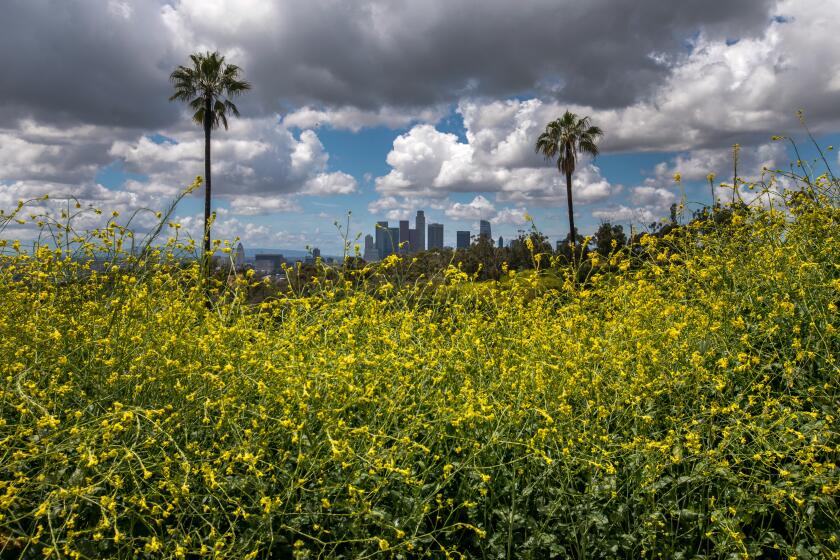Op-Ed: Californians, like polar bears, have something to fear as Arctic ice melts
Southern California is recovering from its worst fire season and a brutal five-year drought that dried out crops, shrank municipal water supplies and killed millions of trees in state, national and urban forests.
By all accounts, it is going to get a lot worse as the climate continues to heat up, and as the cyclical nature of drought resumes its unpredictable course. One of the drivers of change is rapidly melting sea ice at the top of the world.The Arctic Ocean once hibernated, blanketed by the cold, for most of the year. Now increasingly ice-free, the northern polar sea is waking up and vying with La Niña and El Niño as a force that shapes weather patterns in the Golden State.
Here’s one way it plays out: The jet stream isn’t what it used to be. This fast-flowing river of air snakes around the Northern Hemisphere at altitudes of up to four miles, creating high and low-pressure areas and dragging weather along with it. It is powered by the difference in temperature between cold Arctic air and the warmer air to the south. As the Arctic warms, and the temperature difference diminishes, the stream’s westerly winds weaken.
Just such a shift was associated with the “ridiculously resilient ridge” that hunkered down over most of California last fall, persistently redirecting wet weather northward to Alaska, which at one point got a record 40 inches of very wet snow in 12 hours. Weaker westerly winds in turn amplified the stream’s north-south swings, sending cold air much farther south than it usually does, and holding it there. (Did you notice the Texas Rangers opened their spring season on near-record or record cold days?)
And then, the wildfires.
In retrospect, we had a hint back in 2003 that they too were connected to disappearing Arctic ice, when the Cedar fire burned big in San Diego County. Fifteen people were killed and more than 2,800 buildings were destroyed. Wildfire’s reach that year extended into Washington, Oregon, Idaho, Montana, British Columbia in Canada and as far away as the west coast of Hudson Bay, where female polar bears migrate inland to den in the boreal forest. As it turns out, 2003 nearly broke the record for sea ice loss, a record that had been set just the year before.
In all, 13 of California’s 20 largest fires have burned since 2003, when sea ice began retreating in earnest.
Scientists were beginning to talk about a tipping point, when winter’s freezing power could no longer keep up with the ice that melts in summer. When sea ice reached another record low in 2007, California once again burned big. The Zaca and Witch fires, in Santa Barbara and San Diego counties, respectively, were the second and fourth largest in the state’s history.
My eureka moment came in the summer of 2012, another record year for receding sea ice. By summer’s end, it would measure about 1.1 million square miles; in 2003, it had covered about 2.9 million square miles.
I was on a small boat sailing through the eastern Arctic. The only significant ice we encountered in six weeks were the remnants of an enormous iceberg (100 square miles) that had calved off Greenland’s Petermann Glacier two years earlier. By the time we disembarked, the Rush fire in Lassen County had come close to breaking the record for acreage burned. The next year, the giant Sierra Nevada Rim fire paralleled another almost-record low for summer sea ice. And when last year’s horrific Thomas fire hit, the winter Arctic sea ice was well on its way to another low in recorded history.
In all, 13 of California’s 20 largest fires have burned since 2003, when sea ice began retreating in earnest. In recent months, three major studies have been published connecting sea ice loss to wildfire and to wildfire’s helper — drought — in California and the West.
Californians are familiar with two types of fire: the Santa Ana-driven conflagrations that occur in the fall, before the rain comes, and earlier fires driven by extreme summer heat. As the climate continues to heat up, according to UCLA climate scientist Alex Hall, the summer fires will play a larger role in the overall fire risk in Southern California.
No one knows exactly how melting sea ice will factor into this alarming scenario, but its correlation with big fires tells us that it will be a factor. With the Arctic warming twice as fast as the rest of the world, the northern seas are likely to be mostly ice-free in summer by midcentury. Will this mean more “ridiculously resilient ridges”? A jet stream that simply stops swirling across California in anything like the pattern, and carrying the rains, we used to know? Fire seasons that never end?
The warming and cooling of parts of the Pacific — La Niña and El Niño — have a new partner contributing to California weather: the melting Arctic. Like the polar bears, we should be concerned.
Edward Struzik is a fellow at the Institute for Energy and Environmental Policy at Queen’s University in Canada and the author of “Firestorm, How Wildfire Will Shape Our Future” and “Future Arctic, Field Notes From a World on the Edge.”
Follow the Opinion section on Twitter @latimesopinionand Facebook
More to Read
A cure for the common opinion
Get thought-provoking perspectives with our weekly newsletter.
You may occasionally receive promotional content from the Los Angeles Times.






